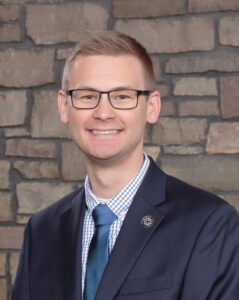By Alex Wesaw, PhD; Director of the American Indian Relations Division of the Ohio History Connection
Bozho, Alex Wesaw nde zhnëkas. Pokégnek Bodwéwadmi ndaw. Hello, I am Alex Wesaw. I am enrolled with the Pokagon Band of Potawatomi Indians. This is how we introduce ourselves in the Potawatomi language. The Pokagon Band of Potawatomi Indians are a federally recognized tribal government, located in southwestern Michigan and northern Indiana.

I have the privilege of serving as the director of the American Indian Relations Division of the Ohio History Connection, a staff position created less than 10 years ago that demonstrates the increasing recognition of the importance of these relationships between Federally Recognized Tribes (FRTs)and the state’s history partner.
While I am a citizen of the Pokagon Band, I have lived my entire life here in Ohio. I grew up in Bremen in Fairfield County. In my position at Ohio History Connection, I manage the relationships our organization has with 45 federally recognized tribal governments that historically have connection to the lands we now know as Ohio. Those Tribes are now located in Indiana, Kansas, Michigan, Minnesota, Missouri, Montana, New York, Oklahoma, Texas, and Wisconsin. Unfortunately, there are no FRTs located in Ohio.
This is a direct result of the removal policies set by our federal government—specifically the Treaty of Greenville of 1795 (Darke County), which ended the Northwest Indian War and removed Tribes from most of what would soon become the state Ohio, except for the northwestern corner. Today there are 574 FRTs in the United States. While there are no FRTs in the state today, there is an abundance of tribal history here and countless tribal influences on our state and communities. Many Ohioans may not even realize it—including even our state name.
The term Ohio is derived from a Seneca word Ohi:yo’ meaning good river. This is in reference to the Ohio River, which forms most of Ohio’s southern boundary has since become so important to the economy of the state and the nation. Second, think about those road signs informing you that you are leaving one county and entering another. Many of those county names come from tribal languages, are English names of Tribes, or have connection to a historical event involving Tribes. Some examples:
- Ashtabula (an Algonquian language word for fish river),
- Auglaize (a Shawnee word for fallen timbers river),
- Clark (where General George Rogers Clark had a conflict with the Shawnee near Springfield),
- Coshocton (a Delaware, or Lenape, word for union of waters),
- Cuyahoga (a Haudenosaunee word for crooked river),
- Delaware (named after the Delaware, or Lenape, people),
- Muskingum (derived from a tribal word meaning by the river side),
- Ottawa (named after the Ottawa or Odawa people),
- Scioto (thought to come from a Wyandotte word for deer),
- Wyandot (named after the Wyandotte people).
Tribal influences around the State goes beyond place names—think about the numerous earthworks that have been constructed around the state. The Great Serpent Mound, in Adams County, is world-renowned with visitors traveling from all over the world to see it for themselves.
The mounds known today as the Hopewell Ceremonial Earthworks in Licking, Ross and Warren counties were places of ceremony or places of reverence to the Indigenous landscape architects that designed their layout such that they align with the stars in the sky and specific alignments of the moon at night. The name Hopewell comes from someone named Mordecai Hopewell who happened to own the land that several earthworks are located on at the time archaeologists excavated the mounds. There is not an agreement upon term by the 45 Tribes on what to call the earthworks today. We know today that the Indigenous individuals that constructed the earthworks are ancestors of the modern-day tribes. Ohioans are excited about our quest to gain World Heritage inscription for these earthworks so that they may receive the recognition they deserve on the world stage and, from my perspective, partnering with Tribes through this process and beyond it, is going to be critical to properly educating those visiting the sites.
As we are conclude National Native American Heritage Month, I encourage you to consider the influences that our Indigenous predecessors left on our landscape and our culture. It is worth remembering that our nation’s 250th anniversary is an important milestone worth recognizing. We should also take this opportunity to reflect on the under-told histories of the people who lived here for thousands of years before Ohio was settled. They are an incredibly important part of Ohio’s contribution to the national narrative then and now.